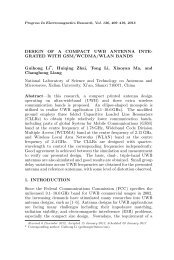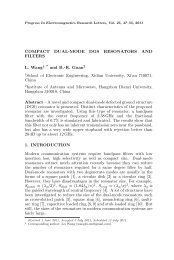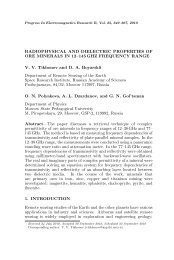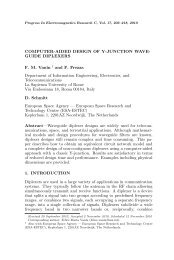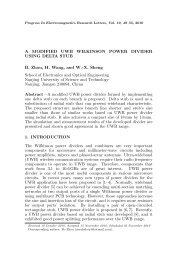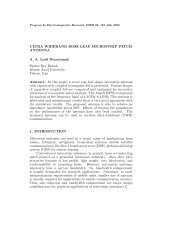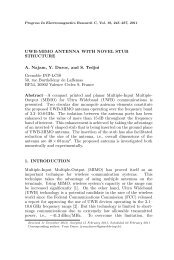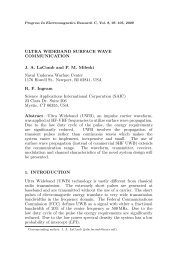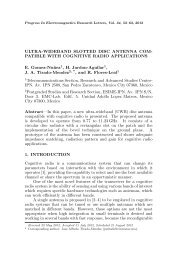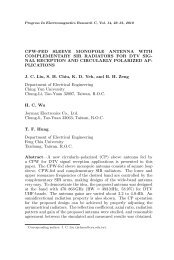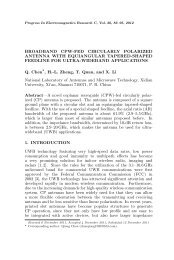LINEAR AND CIRCULAR ARRAY OPTIMIZATION: A STUDY ... - PIER
LINEAR AND CIRCULAR ARRAY OPTIMIZATION: A STUDY ... - PIER
LINEAR AND CIRCULAR ARRAY OPTIMIZATION: A STUDY ... - PIER
You also want an ePaper? Increase the reach of your titles
YUMPU automatically turns print PDFs into web optimized ePapers that Google loves.
356 Khodier and Al-Aqeel<br />
function is used to evaluate the fitness:<br />
⎛<br />
⎜�<br />
�<br />
1<br />
fitness = min ⎝<br />
∆φi<br />
i<br />
φui<br />
φli<br />
⎞<br />
|AF (φ)| 2 ⎟<br />
dφ⎠<br />
(5)<br />
where [φli, φui] is the spatial regions in which the SLL is suppressed<br />
and ∆φi = φui − φli. The sidelobe regions are specified by<br />
φl1 = 0 ◦ , φu1 = 81 ◦ , φl2 = 99 ◦ , φu2 = 180 ◦ . (6)<br />
The integration in (5) doesn’t have a closed form and should be<br />
evaluated numerically. For this purpose, we use a 32 point Gaussian-<br />
Legender method.<br />
2.2.1. Optimize Element Amplitudes In<br />
The amplitudes are initialized randomly within the interval [0, 1] which<br />
also represents the searching region. Table 8 shows the corresponding<br />
amplitudes and Figure 11 shows the array radiation pattern compared<br />
with the pattern of conventional case.<br />
It can be seen from Figure 9 that the conventional array exhibits<br />
relatively high SLL, while the PSO algorithm offers an improvement in<br />
terms of SLL suppression. Table 8 shows that the element amplitudes<br />
are decreasing from the center of the array to the edges.<br />
Table 8. 2N = 10 elements optimized with respect to amplitudes<br />
using (5).<br />
Element 1 2 3 4 5<br />
�In� 1.000 0.8122 0.6799 0.5655 0.3546<br />
2.2.2. Optimize Element Phases ϕn<br />
Element amplitudes In’s and positions xn’s are fixed as the λ/2 spaced<br />
conventional array. As a reference, the first element phase is fixed<br />
to zero. The result found by the PSO algorithm is the same as the<br />
conventional array, i.e., ϕn = 0 ◦ for all n = 1, 2, . . . , N, and we can<br />
say that the λ/2 spaced conventional array is optimum in the sense of<br />
minimizing (5).





